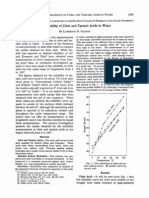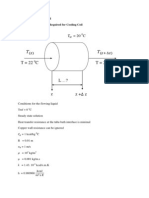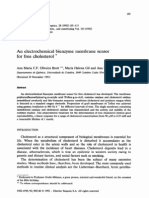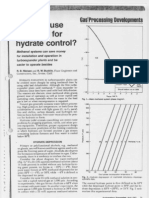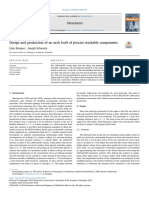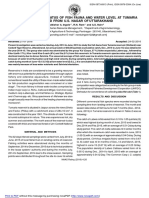Evans 1984
Evans 1984
Uploaded by
PinoteDiegoCopyright:
Available Formats
Evans 1984
Evans 1984
Uploaded by
PinoteDiegoOriginal Description:
Copyright
Available Formats
Share this document
Did you find this document useful?
Is this content inappropriate?
Copyright:
Available Formats
Evans 1984
Evans 1984
Uploaded by
PinoteDiegoCopyright:
Available Formats
Journal o f Solution Chemistry, Vol. 13, No.
2, 1984
Critical Micelle Concentrations for
Alkyltrimethylammonium Bromides in
Water from 25 to 160 ~
D. Fennell Evans, t Martin Allen, 1'2
B. W. Ninham, 3 and Abdel Fouda 4
Received October 17, 1983
Critical micelle concentrations were determined by conductance measurements .for
decyl-, dodecyl-, tetradecyl- and hexadecyltrimethylammonium bromide in water
at 25, 60, 95, 130, and 160~
The results are discussed in terms of the equilibrium model and the nonlinear Poisson-Boltzmann model for micelle formation.
The free energies o f transferring a methylene group from water to the oil-like interior of the micelle are found to be -781 at 25~ -796 at 60~ -819 at 95~
-815 at 130~ and -787 at 160~ cal-mol "l.
KEY WORDS: Critical micelle concentrations;
bromides; hydrophobic interactions.
alkyltrimethylammonium
1. I N T R O D U C T I O N
There is surprisingly little information on micellar properties in
water at elevated temperatures. With the exception of critical micelle
concentrations (CMC) for tetradecyltrimethylammonium bromide (l~
which have been determined up to 166 ~ there is little information on
micelles above 90 ~
An analysis of the change of the CMC with
temperature provides information on hydrocarbon-water interactions
across an extensive temperature range. With increasing temperature,
1Department of Chemical Engineering and Materials Science, University of Minnesota, Minneapolis,
MN 55455.
2Department of Chemistry, College of St. Thomas, St. Paul, MN 55105.
3Department of Applied Mathematics, Research School of Physical Sciences, Australian National
University, Canberra ACT 2600, Australia.
4Department of Chemistry, Mansoura University, Mansoura, Egypt.
87
0095-9782/84/0200-08753.50/0 9 1984 Plenum PublishingCorporation
88
Evans, Allen, Ninham, and Fouda
the unique structural properties of water diminish and water becomes a
more normal polar fluid. The analysis by Shinoda (3~ suggests that this
occurs at 160 ~
In this paper we report CMC's for a homologous series of
alkyltrimethylammonium bromides from 25 to 160 ~C.
2. EXPERIMENTAL
The alkyltrimethylammonium bromides (Eastman Kodak) were
recrystallized from acetone and dried in a vacuum oven at 6 0 ~ .
Surface tension measurements o n solutions of purified samples gave no
indication of a minimum near the CMC.
Doubly distilled
CO2-saturated water was used in the preparation of all solutions.
The resistance measurements were made on a Jones-Dole conductance bridge. The conductance bath was an insulated 16 liter stainless steel vessel filled with silicone oil (Dow-Corning 200). The bath
temperature was set with a platinum resistance thermometer and controlled with a Tronac Precision Temperature Controller (Model
PTC-40). Above 25 ~ some cooling to the bath was provided by
passing compressed air through a 0.25 in. copper tube immersed in the
bath; at 25 ~ water was passed through the cooling coil. The top of
the bath was covered with a polycarbonate (Lexan 1 / 4 in.) shield to
protect lab personnel from being sprayed with hot silicone oil in the
event of equipment failure at elevated temperatures and pressures.
The conductance measurements were made using a flow
system. (~ The solution flow rate and pressure were set using a metering pump (Cheminert Model #301) on the intake and a fine metering
valve on the exit. Above 100 ~ the pressure was set to 20 psi above
the vapor pressure of water and a flow rate of 0.3 ml-min 1 was used.
The pump was connected to the flow conductance cell by a short length
of Teflon tubing, a 30 ft. section of 0.03 in. I.D. stainless tubing which
served as a heating coil for the surfactant solution and an 18 in. length
of Teflon tubing which electrically isolated the heating coil from the
conductance cell. The conductance cell was connected to the metering
valve with Teflon tubing which had fittings for a pressure gauge and a
pressure relief valve.
The flow conductance cells consisted (Fig. 1) of pyrex glass tubes
with electrode compartments constructed of 5 mm tubing with 2 x 6
mm rectangular platinum electrodes connected by 2 mm tubing.
Tungsten-pyrex seals were used. The electrodes were placed vertically
in order to eliminate trapping of gas bubbles, particularly when filling
Temperature Dependence of the Critical MiceUe Concentration
89
1
Fig. 1. Flow conductance cell.
the cell. The gold lead wires were soldered to the ends of the tungsten
wire and covered with shrink-fit Teflon tubing. Epoxy cement was
used to insulate the exposed tungsten wire between the end of the
Teflon tubing and the glass tungsten seals. The conductance cell was
connected to the flow system with a Teflon connector (Lyon Technology #020-BOT) with O-ring seals. In our initial studies we used Teflon
valves; however, we encountered considerable difficulty at high temperatures in keeping the valve stem in place.
The Cheminert metering pump was constructed so that only
Teflon and glass components are in contact with the surfactant solution. The stainless steel heat exchange cell was immersed in the oil
bath and insulated from all the other metal components. Thus, there
is no electrical pathway to ground from the surfactant solution. We obtained the same resistance readings when the surfactant solution was
flowing through the cell as when the flow was stopped and the cell contents isolated from the rest of the system by closing the Teflon valves
on top of the cell.
At the beginning of an experiment, the flow system was flushed
Evans, Allen, Ninham, and Fouda
90
Table I. Critical Micelle Molality Concentrations for Decyl-,
Dodecyl-, Tetradecyl, and Hexadecyltrimethylammonium Bromides in
Water at Various Temperatures
~C
25
65
95
130
160
102CloTAB
6.76
7.79
9.36
10.8
17.4
102Ct27FAB 103CI4TABa
1.54
2.19
3.42
6.12
8.66
3.79
6.69
9.83
21.4
39.4
i03CI6TAB
0.955
1.55
2.61
6.12
13.03
aCMC's for C14TABat these temperatures were obtained from data given in Table II by
interpolation.
by running surfactant solution through at a flow rate of 2.8 ml-min "~ for
20 minutes. The flow rate was then reduced to 0.3 ml-min 1 and the
resistance measured. The next surfactant solution was then used to
flush out the system. Resistances of a total of eight to nine solutions
and the solvent were measured at each temperature for each surfactant.
In several cases, we passed a concentrated sample through the
flow system, at elevated temperature, and used it to measure surface
tension at 25 ~ over a concentration range which included the CMC.
We found no evidence for surfactant decomposition (i.e., no minimum
in -/near the CMC) at the temperatures studied.
3. RESULTS AND DISCUSSION
Critical miceUe concentrations in moles per kilogram of water for
the decyl (CtoTAB), dodecyl (Ct2TAB), tetradecyl (CI4TAB) and
hexadecyl (C16TAB) trimethylammonium bromides at 25, 95, 130, and
160 ~ are given in Table I. The CMC's were determined from plots of
1 / ll (reciprocal of resistance) vs. concentration using the data given in
Table II.
At low temperatures, the CMC is readily identified by a sharp
break in the conductance plot. At higher temperatures the break is
much less pronounced, reflecting the decrease in micelle aggregation
numbers. At present there is no quantitative information on the
change of micelle size with temperature. However, tracer diffusion
measurements using the water insoluble dye, methyl yellow, in C 14TAB
solutions permit aggregation numbers tO be estimated using Stokes'
Law. These give surfactant aggregation numbers of 70, 50, and 30 at
Temperalure Dependence of the Critical Micelle Concentralion
91
Table II. Reciprocal Resistances and Molat Concentrations
of Aqueous Alkyltrimethylammonium Bromide Solutions
at Various Temperatures
102m
10612-1
C10TAB,25~
1.018
4.83
3,012
13.34
5.154
21.52
6.161
25.06
7.159
27.48
8.233
29.49
10.315
32.09
15.642
38.59
CloTAB,160~
10.315 163.5
12.03
186.88
13.47
205.09
15.64
233.22
18.08
262.92
20.00
28533
21.59
302.20
23.37
322.46
25.48
343.37
ClffAB,130~
2.016
30.848
3.032
45.097
3,216
53,967
3.927
56.900
5.081
71.866
5.138
72.487
5.911
81.597
6.784
90.909
8.228 104.05
9.332 113.50
102m
106~-1
C1oTAB,65~
3,012
25.51
5:154
41,41
5A54
41.55
6.161
48.03
7.159
55.08
8.233
61.43
10.315
69.11
15.642
88.57
102m
106~-1
CtoTAB,95~
6.161
61.05
7.159
66.00
8.233
86.18
10.315 104.31
15,642 140.50
12.03
117.18
13.47
126.74
18.08
154.23
C12TAB,25~
0.5386
2.609
0.8218
3.915
1.025
4.818
1.539
7,021
2.016
7.740
3.022
8.904
3.927
9.932
5.081
11.282
Ct2TAB,65~
0.5386
4.920
0.8218
7.364
1.025
9.014
1.539
13.39
2.016
16.995
3.032
20.867
3.927
23.207
5.081
26.451
C12TAB,160~
3.927
67.641
5.081
85.442
5.138
79.780
5.911
97.985
6.784 110.56
8.228 130.82
9.332 145,74
1 1 . 0 3 8 163.75
11.996 178:21
12.949 189.09
CI4TAB,25.2~
0 . 1 2 2 8 9 0.6568
0.15644 0.8337
0.202040 1.0685
0 . 2 5 5 9 0 1.3460
0.30183 1.5809
0.50274
2.1437
0.60819
2.2780
0.69975
2.3910
0.85754 2.5864
102m
106~-~
CloTAB,130 ~
6,013
85.81
6.997
97.97
8.233 113.27
10.315 137.73
12.03
157.73
13.47
172,19
1L642
192.19
18.08
218.83
20.00
236.46
C12TAB,95~
0.7603
9.004
2.016
23.683
3.032
33.809
3.927
41.038
5.138
47.095
5.911
51.344
6.784
55.654
C14TAB,40.3 ~
0.12264 0.8597
0.15642 1.0911
0.20267 1.4081
0.25345 1.7505
0.33853 Z3201
0.44278 2.8651
056762 3.1611
0.74256 3.501
0.99318 3.963
0.65634 3,327
0.86077 3.698
1.1024
4.168
Evans, Allen, Ninham, and Fouda
92
Table II. (Continued)
103m
106f1-1
C14TAB,73.6 oC
1.5434
1.9615
2.5512
3.3180
4.2302
5.4142
7.2831
9.6610
16.231
8.6077
11.024
12.360
14.348
103m
C14TAB,95.5Oc
1.6975 1.2264
2.1464 1.5642
2.7086 2.0267
3.5951 2.5345
4.5486 3.3853
5.8025 4.4278
7.2218 5.6762
8.2223 7.4256
10.579
9.9318
7.8028 6.5634
8.7123
8.6077
9.2003 9.9766
9.9071 1 1 . 0 2 4
12.360
14.348
15.764
CI4TAB,166.0~
4.9997
9.7305
9.9969 1 8 . 8 3 6
15.167
27.929
19.967
36.246
50.020
82.485
54.638
88.65
61.205
95.795
66.853 103.00
73.694 109.71
1061/-1
103m
C14TAB,114
oC
1.6894
1.5434
2.1445 2.5512
2.7660 3.3180
3.4441
4.2302
4.5653
5.4142
5.9287 7.2831
7.5398 9.6610
9.7761 16.231
12.598
17.994
8.6813 18.736
11.205
21.405
12.635
20.062
13.462
14.333
15.450
16.202
C16TAB,25~
0.4996 0.23878
0 . 5 9 8 3 0.27922
0 . 7 0 5 3 0.33113
0 . 8 1 0 3 0.38264
0 . 9 0 2 8 0.41873
0.9941
0.44800
1.1946
0.47628
1.4000
0.50281
1.6102
0.52323
1.8477
0.55774
106~-1
103m
CI4TAB,134.9
o
2.4990
1.9615
4.0335
3.3180
5.2087 4.2302
6.5961
5.4142
8.3659 7.2831
11.130
9.6610
14.575
16.231
22.628
17.994
19.803
12.219
24.723 21.406
26.665 20.062
25.642 23.363
26.672
29.957
34.182
C16TAB,65
~
0.4996 0.47191
0.5983 0.55177
0:7053 0.64830
0.8103 0.74547
0.9028 0.82694
0.9941 0.90872
1.1946 1.0882
1.4000 1.2636
1.6102 1.4165
1.8477 1.5251
2.1984
1.5969
2.5108
1.7553
106~ .1
3.3450
5.5529
7.0130
8.9019
11.831
15.518
25.344
27.874
19.390
32.467
30.728
34.841
38.320
41.302
44.815
C16TAB,95
~
1 . 6 1 0 2 1.9940
1 . 8 4 7 7 2.3013
2 . 1 9 8 4 2.7426
2 . 5 1 0 8 3.0842
2 . 6 9 7 7 3.2964
3 . 0 0 5 5 3.5934
3 . 3 0 9 4 3.8372
3 . 6 1 4 9 4.0103
0 . 5 9 9 6 0.6530
0 . 5 9 8 3 0.7668
0 . 7 0 5 3 0.8906
0 . 8 1 0 3 1.0230
0.9023
1.1352
0.9941
1.2216
3.2165
4.116
3.4072
4.2583
Temperature Dependence of the Critical Micelle Concentration
93
Table II. (Continued)
103m
106~-1
103m
0.5996
0.5983
0.7053
0.8103
0.9023
0.9941
4.3400
4.8313
5.3466
CI6TAB,130~
0.8839 5.8990
1.0880 5.8990
1 . 2 7 5 3 6.3611
1.4537 6.8260
1 . 6 9 1 8 7.3253
1 . 7 7 0 3 7.8833
7.4327 8.3318
8.3325 8.9636
9.1859
106f~-I
103m
9.9762
9.9762
10.754
11.368
11.974
12.489
12.904
13.773
0.4996
0.5983
0.7053
0.8103
0.9023
0.9941
8.2871
8.9864
106~-l
103m
C16TAB,160~
1.083
11.891
1.289
13.003
1.471
14.170
1.694
15.955
1.860
17.966
2.085
19.933
17.474
21.844
18.616
24.125
106~-1
23.151
25.025
26.972
29.388
31.318
33.836
35:161
38.699
25, 95, and 130~ (4) With decreasing size the CMC becomes less
sharply defined since aggregation occurs over a larger concentration
range.
In previous publications (t'6) we analyzed the change of CMC with
temperature for C~4TAB to obtain the thermodynamics of transferring
the hydrocarbon chain from water to the oil-like interior of the micelle.
We have used two models, the equilibrium model (7> and a nonlinear
Poisson-Boltzmann model. (8~ Since these models can be used to obtain
insight into the nature of micelles at high temperature and the nature
of hydrocarbon-water interactions over an extended temperature range,
they will be described below.
According to the equilibrium model, an equilibrium between
monomers S +, counterions S - a n d monodisperse micelles M +p can be
represented by
NS + + ( N - p ) A - = M +p
(1)
The equilibrium constant K is related to the standard free energy of
micelte formation per monomer unit by
RTlnK = RTlnXcMc = ~XGHp/N- (1 -/3 )RTtnXcMc
(2)
where/3 = p/N. For a typical micelle (N = 50 to 100), the term
(R T~ N)lnXcM+P is small and consequently insensitive to large errors in
the estimated M +p, and is usually dropped in going from Eq. (1) to
Eq. (2). The form of Eq. (2) emphasizes that R TlnXcMc is the experimentally measured free energy of transferring a surfactant
Evans, Allen, Ninham, and Fouda
94
200
I l l l l l t l
12
14
180
160
140
120
50
T
~c:~100
0
80
60
95
40
0
0
~
2
65
10
~02rn ( r n o l e s - k g -1)
Fig. 2. Reciprocal resistances of dodecyltrimethylammonium aqueous solutions as a function of molality at various temperatures. The CMC's are indicated by arrows.
monomer from the solvent to the micelle, A G . p / N is the free energy
per mole of monomer of transferring the hydrocarbon tail from the
solvent to the oil-like interior of the micelle and (1 -/3 )RTlnXcMc is
the contribution to the free energy arising from the electrostatic interaction at the surface of the micelle.
The enthalpy for micelle formation is given by
AH = RTI[(2-/3 )(OlnXcMc/OT)p + lnXcMc (0/3/OT)p]
(3)
In this form, the equilibrium model assumes that the micellar aggregation number does not change with temperature and that all changes in
the surface electrostatic interactions with temperatures are given by
(~/3/0 T). In our analysis of C ~4TAB we estimated/3 from the changes
Temperature Dependence of the Critical Micelle Concentration
95
Table I I I . C o m p a r i s o n of T h e r m o d y n a m i c Transfer Quantities for
Transfer of a Surfactant H y d r o c a r b o n Chain f r o m Water to the Oil-Like
Interior o f a Micelle, using the Equilibrium and Poisson-Boltzmann
Models a
~
-AG b
25
9.95
10.5
10.2
10.9
10.2
11.1
10.2
11.4
10.1
11.5
9.6
11.3
9.2
11.1
8.54
10.6
40.3
54.2
76.3
95.5
114.0
134.9
166.0
-AH b
6.8
3.0
8.6
4.4
10.2
5.6
12.9
8.2
15.9
12.4
16.6
14.7
17.9
15.6
18.3
15.6
AS c
10
25
5
20
0.1
16
-8
9.5
-16
-2.5
-18
-8
-21
-11
-22
-12
1 -~
0.75
(0.85)
0.72
(0.84)
0.68
(0.83)
0.62
(0.82)
0.58
(0.82)
0.50
(0.77)
0.45
(0.75)
0.35
(0.70)
70
65
60
55
50
35
30
20
arhe data are for C14TAB; for each temperature the first entry is calculated using the
equilibrium model, Eq. (2), the second entry is calculated using the Poisson-Boltzmann
l
c
model, Eqs. (4-9). bKcal-mol-.
Cat-mol-KI
in slope of the specific conductance a b o v e and below the CMC, and obtained a value of 0 / 3 / O T = 0.003. W e obtained the values o f A G , AH,
and AS given in Table III.
According to the nonlinear Poisson-Boltzmann m o d e l the C M C
can be expressed as
R TlnXcM c = (4x~ -/x ~ = - - A GHp + g~
(4)
where Ix ~ a n d / ~ ~ are the chemical potentials of m o n o d i s p e r s e d micelles
and m o n o m e r s and s s describes the surface contributions.
In the
model, g s is written as the s u m
g s = Y oa + g e~
(5)
where g o~ is evaluated f r o m the nonlinear Poisson-Boltzmann equation
Evans, Allen, Ninham, and Fouda
96
for spherical geometry to give
g~/2kT = [ln(1/2s + ~,/1 + (1/2s) 2) + (1 - ~ 1 + (lhs) 2) / 0/as)
- (2/KRs)(1 + , J l + ( l h s ) 2 )
...~]
(6)
where K z = (8rrn2o/ekT) and s = 4rre2/eKakT. K -~ is the Debye
length, s is the scaled charge density, and R is the radius of the micelle.
In Eq. (5), the first term is the electrostatic free energy of a flat double
layer and the second an explicit correction due to curvature of the
surface, a is the surface area per surfactant molecule and 3, o is the
surface tension at the hydrocarbon-water interface that is assumed to
be constant. Contributions to g~I arising from stericrepulsion, hydration, and entropic terms are not included in the model and consequently are implicitly included in ~ o.
For the micelle at equilibrium
3 g ~ t / O a = (yo +
y~,) =
(7)
from which
2eK
~ e l = --
rr
T
(____2_")2 [sinh2(yo/4) +
e
2
KR
In cosh(yo/4) + . ..] (8)
where the scaled surface potential Yo = etOs/kT can be determined
from the equation
S = 2sinh(yo/2) +
4
KR
tanh(Yo/4)
(9)
These equations depend on the variables K, a and R. For spherical
micelles R and a can be related geometrically by the relations
4rrR 2= Na,
(4~"/3)R 3 = N V
(10)
where V is the volume of the hydrocarbon core which is calculated
from
V ( A 3) =
27.4
+26.9nc
Here, n, is close to the number of carbon atoms per chain. The fully
extended chain length is lc(A) = 1.5 + 1.265n~.
135
90
55
21.4
15.7
14,2
12.4
18.9
17.9
16.9
16.6
14.1
64
77
85
97
64
67
72
63
63
10.00
6.21
5.94
5.53
8.16
8.02
7.85
6.76
5.27
2.47
2.18
2.19
2.18
2.47
2.50
2.54
2.27
1.98
~ a/kT
7.51
4.00
3.71
3.28
5.66
5.49
5.27
4.46
3.25
gel/kT
entries for CI4TAB illustrate the effect of aggregation number on the calculated quantities.
25
40
30
20
25
Ct4TAB
CI6TAB
70
60
50
25
C12TAB
40
25
CIoTAB
Surfact.
5,917
5,011
4,781
4,424
4,822
4,737
4,632
3,989
3,101
gs
6,495
6,373
5,682
4,851
3,975
-R TInXcMc
Table IV. Calculated Free Energies for the Alkyltrimethylammonium Bromides
at 25~ using Eqs. (4-9)o
12,412
11,384
11,155
10,798
10,504
10,419
10,314
8,840
7,076
-AGHp
0.91
0.79
0.75
0.69
0.85
0.83
0.81
0.82
0.78
(1-,8)
9"
N"
r
-i
t~
-1
t~
-4
98
Evans, Allen, Ninham, and Fouda
The Poisson-Boltzman model allows the free energy of micelle
formation to be explicitly written in terms of molecular variables which
characterize the micelle. In particular the effect of aggregation number
can be directly ascertained. However, a limitation arises from treating
the counterions as point charges. As a consequence, the specific differences among various counterions (e.g. OH-, CI, Br, I-) require the
introduction of an additional parameter. For example, the difference
between micelles with bromide and hydroxide counterions (described
below) can be accounted for by assuming that the hydroxide ion is
located 4 A from the surface of the micelle.~6)
The quantities calculated for C14TAB at 25 ~ with N = 80 to 40
and at 130~ with N = 50 to 10 are given in Table IV. For a typically
large micelle at room temperature the change in A GHp is small. For
example the change in AGup from N = 70 to N = 60 is 140 cal-mol-~i
For the smaller micelles encountered at higher temperatures, A G,p is
much more sensitive to changes in N, e.g. from N = 30 to 20 the
change is 425 cal-mol ~, inspection of Table IV shows that the decrease
of y and the increase of a with N almost compensate one another in
y a/K T. Consequently, it is the variation of y e~with changing curvature
that is responsible for the dependence of gs and consequently /~GHp
upon aggregation number. Also given in Table IV are values for the
other alkyltrimethylammonium bromides using the measured aggregation numbers. With the aggregation numbers estimated from the dye
diffusion measurements, the free energy for transferring the tetradecyl
hydrocarbon chain from water into the micelle are given in Table III.
The values of A H a n d AS were determined from a plot of AGHp vs. T.
The equilibrium model and the Poisson-Boltzmann models can be
compared in terms of Eqs. (2) and (4) which show that they are equivalent provided
gs = RT(1 -/3 )In XcMc
(11)
It is clear that the ion binding paramter (1 -/3) must account for
all changes in g~, y o and N with temperature. It is not surprising that
the thermodynamic quantities AH and AS differ somewhat as determined by the two models. In fact, Eq. (11) in the form
(1 -/3) = g s / R T l n XCMc
(12)
provides a way of calculating this parameter from theory. The 313 / ~ T
used for the equilbrium model is 3 10 3 while that obtained from Eq.
]-emperature Dependence of the Critical Micelle Concentration
-2
O-- ~
,.. ~ #~ ; ~ ^
~-...
"-~.
99
-CH 2-
25oc
60~
95~
150~
-781 ( c a l / m o ] )
-796
-819
-815
"
-4
-6
-8
I
10
J
I2
I
t6
"14
iilii
18
nc
Fig. 3. The dependence Of In CMC on the carbon number n c at various temperatures and
the free energies of transfer of a methylene group from water to the micelle as determined from Eq. (12).
(12) is 7 x 10 -4. These differences reflect, at least in part, an implicit
inclusion of 3r / ~)T in 3/3 / ~1T for the equilibrium model.
The change of lnXcMc vs. carbon number for all the surfactants at
the various temperatures is shown in Fig. 3. At 25 and 65 ~ all of the
data points lie on a straight line, however, the values (with increasing
temperature) for C 10TAB fall progressively below the straight line.
The straight lines can be represented by
In Xcc = ao +
aln c
(13)
which in terms of the equilibrium model [Eq. (2)] can be given as
O A G / O n ~ = R T ( 1 - ~ )al
(14)
This permits the free energy of transferring a methylene group from
100
Evans, Allen, Ninham, and Fouda
the solvent to the micelle to be calculated. We have employed the
value of (1-/3) calculated from Eq. (12). The free energies show a
maximum near 100~ which corresponds to a minimum in the
solubility. Above this temperature the free energy decreases corresponding to the usual behavior of increasing solubility with increasing
temperature. Below 100 ~ the solubility of hydrocarbons is increased,
not decreased, by the unique structural properties of water around nonpolar groups. Similar behavior was observed by Shinoda (3) from an
analysis of the solubility of alkylbenzenes and alcohols as a function of
temperature.
The anomalous behavior of C10TAB with increasing temperature
can be understood in the following way. At 25 ~ N=39. With increasing temperature N decreases and more of the hydrocarbon chain is
exposed to water. Parallel behavior is shown by the alkyltrimethylammonium hyroxide at 25 ~ The CMC's for the hydroxides are twice as
large as those for the bromides while the aggregation numbers are considerably smaller. (9m For C~4TAOH, CMC = 7.2x 103M, N = 4 4 and
(1,/3) = 0.40 compared to the CMC = 3.6x 103M, N = 70 and (1-/3)
= 0.75 for C14TAB. The differences reflect the strongly hydrophilic
nature of the hydroxide ion which takes a position further away from
the micelle surface than the bromide ion.(67 This results in an increased
electrostatic repulsion between the headgroups, a larger a and a corresponding decrease in N. The free energy of transferring a methylene
group from water to the micelle are very different for these two
couterions. Equation (14) gives -520 cal-mol ~ for the hydroxide surfacrants compared to -780 cal-mol ~ for the corresponding bromides. This
corresponds to approximately two more methylenes groups of the
hydrocarbon chain being exposed to water when the counterion is
hydroxide.
The discussion given above clearly illustrate that any detailed
analysis of the themodynamics of micelle formation will require aggregation numbers as a function of temperature. However, the analysis
of dependence on chain length for all the surfactants studied and for
C~4TAB with the activated aggregation numbers provide a consistent.
The free energy of transferring a hydrocarbon chain from water into
the micelle shows a minimum in hydrocarbon solubility near 100~
The entropy (AS = ~AG/~T) at low temperatures is positive,
decreases to zero near 100~ and becomes increasingly negative at
higher temperatures. The enthalpy becomes progressively more negative with increasing temperature. These compensating changes in ~ H
and AS demonstrate that the changes in water around hydrocarbon
Temperature Dependence of the Critical Micelle Concentration
101
chains have only a small effect on the solubility of nonpolar groups in
aqueous solutions. ~12)
ACKNOWLEDGMENT
T h i s w o r k was s u p p o r t e d by t h e N a t i o n a l S c i e n c e F o u n d a t i o n a n d
U.S. A r m y C o n t r a c t N o . D A A G 2 9 - 8 1 - K - 0 0 9 9 .
REFERENCES
1. D. F. Evans, and P. J. Wightman, J. Coll. and Interf Sci. 86, 515 (1982).
2. P. Mukerjee and K. J. Mysels, Nat. Stand. Ref. Data Serv., Nat. Bur. Stand.
U.S. 36.
3. K. Shinoda, J. Phys. Chem. 81, 1300 (1977).
4. D. F. Evans, S. Mukherjee, D. J. Mitchell, and B. W. Ninham, J. Coll. and
lntecf. Sci. 93, 184 (1983).
5. S. Mukherjee and D. F. Evans, J. Solution Chem. 11, 871 (1982).
6. D. F. Evans, and B. E. Ninham, J. Phys. Chem. 87, (Nov. 1983).
7. P. Mukerjee, J. Phys. Chem. 66, 1375 (1962).
8. D. J, Mitchell and B. W. Ninham, J. Phys. Chem. 87, 2996 (1983).
9. P. Lianos and R. Zana, J. Phys. Chem. 87, 1289 (1983).
10. S. Hashimoto, J. K. Thomas, D. F. Evans, and S. Mukherjee, J. Coll. and
Interf Sci., (Oct. 1983).
11. P. Lianos and R. Zana, J. Colloidand InterfacialSci. 84, 100 (1981).
12. M. Ramadan, D. F. Evans, and R. L. Lumry, J. Phys. Chem. 87, (Oct. 1983).
You might also like
- Board-Exam May2223242019Document11 pagesBoard-Exam May2223242019Jonnah Faye MojaresNo ratings yet
- Vle of Hcl-WaterDocument6 pagesVle of Hcl-WaterYaqoob Ali0% (1)
- The Solubility of Citric and Tartaric Acids in WaterDocument3 pagesThe Solubility of Citric and Tartaric Acids in WaternhaduongNo ratings yet
- Formaldehyde Project Report by AbhishekDocument98 pagesFormaldehyde Project Report by AbhishekAbhishek Kumar83% (12)
- Copolymerization of Styrene and Acrylonitrile in Aqueous DispersionDocument15 pagesCopolymerization of Styrene and Acrylonitrile in Aqueous DispersionPhilip ShihNo ratings yet
- Ethylene Urea JACS 1Document10 pagesEthylene Urea JACS 1tavolenNo ratings yet
- High-Temperature Continuous Bulk Copolymerization of Styrene and Acrylic Acid Determination of Monomer ConversionsDocument11 pagesHigh-Temperature Continuous Bulk Copolymerization of Styrene and Acrylic Acid Determination of Monomer ConversionsKumaranNo ratings yet
- Accepted Manuscript: J. Chem. ThermodynamicsDocument21 pagesAccepted Manuscript: J. Chem. ThermodynamicsLOLA PATRICIA MORALES DE LA CUBANo ratings yet
- Liquid Liquid EquilibriumDocument9 pagesLiquid Liquid EquilibriumLucas_ABNo ratings yet
- Soal Proses Perpindahan.Document3 pagesSoal Proses Perpindahan.Rin Ririn MahmudatiNo ratings yet
- Ternary Phase DiagramDocument9 pagesTernary Phase DiagramFabiha SheikhNo ratings yet
- Hydro ChlorinationDocument5 pagesHydro ChlorinationIqbal Muhamad IrfanNo ratings yet
- Effect of Poly (Acrylic Acid) End-Group Functionality On Inhibition of Calcium Oxalate Crystal GrowthDocument7 pagesEffect of Poly (Acrylic Acid) End-Group Functionality On Inhibition of Calcium Oxalate Crystal GrowthPencils SharpenerNo ratings yet
- Kinetics of The Thermal Isomerization Bicyclo) Hexane1Document3 pagesKinetics of The Thermal Isomerization Bicyclo) Hexane1Adelmo FilhoNo ratings yet
- Synthesis of Methyl-T-Butyl E T H E R From Methanol and Isobutene Using A Clay CatalystDocument6 pagesSynthesis of Methyl-T-Butyl E T H E R From Methanol and Isobutene Using A Clay CatalystIoana PopescuNo ratings yet
- Preparation of Ketene From Glacial Acetic Acid.Document16 pagesPreparation of Ketene From Glacial Acetic Acid.TIm SnyderNo ratings yet
- Electrochemical Bienzyme Membrane Sensor For Free CholesterolDocument11 pagesElectrochemical Bienzyme Membrane Sensor For Free CholesterolAnand ChelliahNo ratings yet
- CH 08Document44 pagesCH 08kentalNo ratings yet
- A. Karim Et Al. / Catalysis Today 110 (2005) 86-91 87Document2 pagesA. Karim Et Al. / Catalysis Today 110 (2005) 86-91 87Widya AyuNo ratings yet
- fabuss1966Document7 pagesfabuss1966ipekepipekNo ratings yet
- Synthesis of Copolymers Containing 3-Hydroxycyclohexyl Methacrylate and Their Application As Arf Excimer Laser ResistsDocument4 pagesSynthesis of Copolymers Containing 3-Hydroxycyclohexyl Methacrylate and Their Application As Arf Excimer Laser ResistsIbrahim BouniNo ratings yet
- Equilibrium Constants Methyl Tert-Butyl Ether Liquid-Phase SynthesisDocument5 pagesEquilibrium Constants Methyl Tert-Butyl Ether Liquid-Phase Synthesisjulior87No ratings yet
- tmpCF04 TMPDocument26 pagestmpCF04 TMPFrontiersNo ratings yet
- 0867 Tantalum ILDocument8 pages0867 Tantalum ILRamaswami NeelamegghamNo ratings yet
- AssumpdfgDocument5 pagesAssumpdfgozoNo ratings yet
- CH353 Problem Sheet #7 Batch II 2024Document2 pagesCH353 Problem Sheet #7 Batch II 2024SagarNo ratings yet
- Appendix 1: Pressure Calibration of 12.7 MM Diameter Piston-Cylinder AssembliesDocument8 pagesAppendix 1: Pressure Calibration of 12.7 MM Diameter Piston-Cylinder AssembliesSam SalasamNo ratings yet
- Tame Process BasicsDocument10 pagesTame Process BasicsD'Bayour Toke Osuolale100% (1)
- Separation of Ethyl Acetate and Butyl Acetate by Simple Distillation and Analysis of Fractions by GasDocument9 pagesSeparation of Ethyl Acetate and Butyl Acetate by Simple Distillation and Analysis of Fractions by GasMunna Patel100% (1)
- Electrolytic Concentration of Aqueous Solutions of Nitric Acid. I. Henry Jermain Maude CreightonDocument7 pagesElectrolytic Concentration of Aqueous Solutions of Nitric Acid. I. Henry Jermain Maude Creightoneduard morarNo ratings yet
- Dimethyl EtherDocument7 pagesDimethyl EtherAna Laura Sanchez100% (1)
- Feick 1954Document3 pagesFeick 1954magdy salehNo ratings yet
- Geothermics, Vol. 18, No. 1/2, Pp. 83-88, 1989Document6 pagesGeothermics, Vol. 18, No. 1/2, Pp. 83-88, 1989AntoineNo ratings yet
- Bill PaperDocument6 pagesBill Paperkamalakar yahooNo ratings yet
- Quanitative Colorimetric Microdetermination of Methanol With Chromotropic Acid Reagent PDFDocument2 pagesQuanitative Colorimetric Microdetermination of Methanol With Chromotropic Acid Reagent PDFJhon CastroNo ratings yet
- Kinetics and Mechanism of Cyclohexanol Dehydration PDFDocument10 pagesKinetics and Mechanism of Cyclohexanol Dehydration PDFAlberto_Varela0014No ratings yet
- Poly-å-Caprolactam: 1. ProcedureDocument3 pagesPoly-å-Caprolactam: 1. ProcedureMathaneshan RajagopalNo ratings yet
- DMCDocument12 pagesDMCShariq AliNo ratings yet
- A New Trend For Preparating Polymeric CalciumDocument11 pagesA New Trend For Preparating Polymeric CalciumNicolae LucaNo ratings yet
- Equilibrium Data - Water and Acetic Acid, Water and Methanol, and Water and EthanolDocument6 pagesEquilibrium Data - Water and Acetic Acid, Water and Methanol, and Water and EthanolBarbara RicciNo ratings yet
- Chemistry Voltaic Cell IADocument23 pagesChemistry Voltaic Cell IAjfpearce94% (63)
- Reologia Del QuitosanoDocument10 pagesReologia Del QuitosanoSilvana TrujilloNo ratings yet
- Practical Book Analytical ChemistryDocument14 pagesPractical Book Analytical Chemistrysalman ahmedNo ratings yet
- Applied Chemistry I Lab ManualDocument51 pagesApplied Chemistry I Lab ManualBipin PrajapatiNo ratings yet
- Effect of Hydrophobic Chain Length of Surfactants On Enthalpy-Entropy Compensation of Micellization PDFDocument7 pagesEffect of Hydrophobic Chain Length of Surfactants On Enthalpy-Entropy Compensation of Micellization PDF1MM1 UPIITANo ratings yet
- Applied Thermodynamics For Process ModelingDocument8 pagesApplied Thermodynamics For Process ModelingBehnam HosseinzadehNo ratings yet
- Methanol Production From Syngas Reactor DesignDocument48 pagesMethanol Production From Syngas Reactor DesignJasonNtsako100% (2)
- IOSR JournalsDocument6 pagesIOSR JournalsInternational Organization of Scientific Research (IOSR)No ratings yet
- Physical Properties of Sea Water SolutionsDocument8 pagesPhysical Properties of Sea Water SolutionsMarco Antonio CondorettyNo ratings yet
- Cooling TowerDocument63 pagesCooling TowerApsara Katugaha100% (2)
- TEC WaterDocument8 pagesTEC Waterfazrul76No ratings yet
- Expts For Web 10 Jul03 DDocument88 pagesExpts For Web 10 Jul03 Ddavid_benedict_lho6705No ratings yet
- Advanced Pharmaceutical analysisFrom EverandAdvanced Pharmaceutical analysisRating: 4.5 out of 5 stars4.5/5 (2)
- Process Steam Systems: A Practical Guide for Operators, Maintainers, and DesignersFrom EverandProcess Steam Systems: A Practical Guide for Operators, Maintainers, and DesignersNo ratings yet
- A Modern Course in Statistical PhysicsFrom EverandA Modern Course in Statistical PhysicsRating: 3.5 out of 5 stars3.5/5 (2)
- Physical Chemistry of Polyelectrolyte SolutionsFrom EverandPhysical Chemistry of Polyelectrolyte SolutionsMitsuru NagasawaNo ratings yet
- Enhanced Oil Recovery: Resonance Macro- and Micro-Mechanics of Petroleum ReservoirsFrom EverandEnhanced Oil Recovery: Resonance Macro- and Micro-Mechanics of Petroleum ReservoirsRating: 5 out of 5 stars5/5 (1)
- Standard methods for the examination of water and sewageFrom EverandStandard methods for the examination of water and sewageNo ratings yet
- 2012 Paper Eco-ScaleDocument12 pages2012 Paper Eco-ScalePinoteDiegoNo ratings yet
- 2019 Green Extraction Techniques in Green Analytical ChemistryDocument25 pages2019 Green Extraction Techniques in Green Analytical ChemistryPinoteDiegoNo ratings yet
- 2015 Green Chemistry Metrics With Special Reference To GreenDocument19 pages2015 Green Chemistry Metrics With Special Reference To GreenPinoteDiegoNo ratings yet
- Fluorochrome TableDocument5 pagesFluorochrome TablePinoteDiegoNo ratings yet
- PO4-Phosphate Buffers-RECIPES - Preparation of PH Buffer Solutions, PH1.0-PH13.0 - Recipes Ex Web-Delloyd's Lab Tech - Hompage (14!02!18pdf)Document5 pagesPO4-Phosphate Buffers-RECIPES - Preparation of PH Buffer Solutions, PH1.0-PH13.0 - Recipes Ex Web-Delloyd's Lab Tech - Hompage (14!02!18pdf)PinoteDiegoNo ratings yet
- THC SigmaDocument2 pagesTHC SigmaPinoteDiegoNo ratings yet
- Statistical Thermodynamics IIDocument9 pagesStatistical Thermodynamics IIPinoteDiegoNo ratings yet
- OCG - Reading Test 1Document4 pagesOCG - Reading Test 1HânNo ratings yet
- PRIMA FACIE AND ACTUAL DUTIES - William David Ross PDFDocument12 pagesPRIMA FACIE AND ACTUAL DUTIES - William David Ross PDFGintokiNo ratings yet
- Conservation and Management of Mangroves in OrissaDocument34 pagesConservation and Management of Mangroves in OrissaJitendra Prasad SinghNo ratings yet
- Kanya PVS Catalogue 2008Document170 pagesKanya PVS Catalogue 2008james2271No ratings yet
- Prakas Kurniawan Setiabudi: WorkingexperiencesDocument1 pagePrakas Kurniawan Setiabudi: WorkingexperiencesPrakas KurniawanNo ratings yet
- Yuma County Storm Drainage Manual FC - PWSIIIDocument66 pagesYuma County Storm Drainage Manual FC - PWSIIIenrico66No ratings yet
- NTSE 2016 17 Tamil Nadu Answer KeyDocument2 pagesNTSE 2016 17 Tamil Nadu Answer Keysethu pathiNo ratings yet
- Philosophy Essay ExampleDocument4 pagesPhilosophy Essay ExamplehqovwpaegNo ratings yet
- Number, Ranking & Time Sequence: 1. AlphabetsDocument8 pagesNumber, Ranking & Time Sequence: 1. AlphabetsSanjaya SahooNo ratings yet
- Modeling Analysisand Measurementofan High Performance Engine Valvetrain SystemDocument20 pagesModeling Analysisand Measurementofan High Performance Engine Valvetrain SystemvaidyanathanNo ratings yet
- Introduction of Optical AmplifierDocument4 pagesIntroduction of Optical AmplifierCelesteYangNo ratings yet
- "Skepticism" Reborn As "Skeptical Inquiry "Document4 pages"Skepticism" Reborn As "Skeptical Inquiry "Anonymous tBodA9NiNo ratings yet
- WiderWorld 1 LanguageTestU7 GroupBDocument3 pagesWiderWorld 1 LanguageTestU7 GroupBМарія БорухNo ratings yet
- CH 13Document32 pagesCH 13hirenpatel_universalNo ratings yet
- Draft EO - Repealing EO 65 BOD of Local Water DistrictsDocument27 pagesDraft EO - Repealing EO 65 BOD of Local Water DistrictsBernardo DelimaNo ratings yet
- Design and Production of An Arch Built of Precast Stackable Co 2019 StructurDocument7 pagesDesign and Production of An Arch Built of Precast Stackable Co 2019 StructurSteven KuaNo ratings yet
- KBCDocument15 pagesKBCMauricio Huerta JaraNo ratings yet
- RIBA Plan of Work 2013 - PresentationDocument68 pagesRIBA Plan of Work 2013 - Presentationelchuno100% (3)
- Study of Present Status of Fish Fauna and Water Level at Tumaria Wetland From U.S. Nagar, Uttarakhand.Document4 pagesStudy of Present Status of Fish Fauna and Water Level at Tumaria Wetland From U.S. Nagar, Uttarakhand.Journal of Environment and Bio-SciencesNo ratings yet
- Final Group Assignment Topics and Guidelines - 2018Document10 pagesFinal Group Assignment Topics and Guidelines - 2018Rishabh AsthanaNo ratings yet
- Abap Accenture Test1Document5 pagesAbap Accenture Test1Ichigo MangekNo ratings yet
- Delphi Informant Magazine Vol 6 No 9Document37 pagesDelphi Informant Magazine Vol 6 No 9sharkfinmikeNo ratings yet
- MMWW 12Document6 pagesMMWW 12Micay MalinaoNo ratings yet
- Impact Report Kanban ImplementationDocument21 pagesImpact Report Kanban ImplementationMark Lester MagnayeNo ratings yet
- Android WebView Example PDFDocument28 pagesAndroid WebView Example PDFShoaib QuraishiNo ratings yet
- AVCS User Guide For L 3 Valmarine NaviNet ECDIS v1 0Document38 pagesAVCS User Guide For L 3 Valmarine NaviNet ECDIS v1 0Lyubomir Lazarov100% (1)
- FCS-8005 User ManualDocument11 pagesFCS-8005 User ManualGustavo EitzenNo ratings yet
- S.y.b.sc Cbcs Time Table 2024-2025Document1 pageS.y.b.sc Cbcs Time Table 2024-2025prakash.chikte7No ratings yet
- AADE Review of Lost Circulation Materials and Treatments With An Updated ClassificationDocument9 pagesAADE Review of Lost Circulation Materials and Treatments With An Updated ClassificationMuhamad IrfanNo ratings yet
- 2 SHS Challenge - Managing Exits and Outcomes That Achieve Results - Dr. Dina S. Ocampo - CompressedDocument38 pages2 SHS Challenge - Managing Exits and Outcomes That Achieve Results - Dr. Dina S. Ocampo - CompressedJoviner Yabres LactamNo ratings yet



